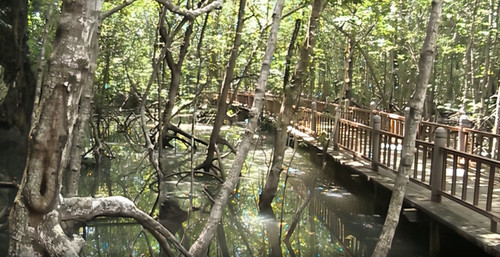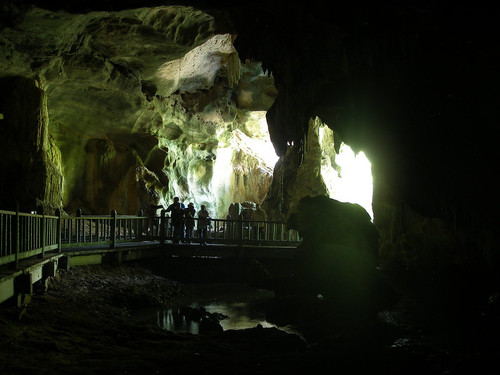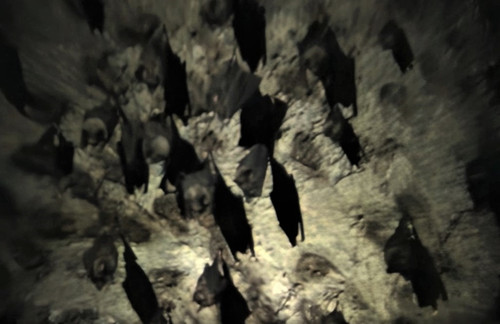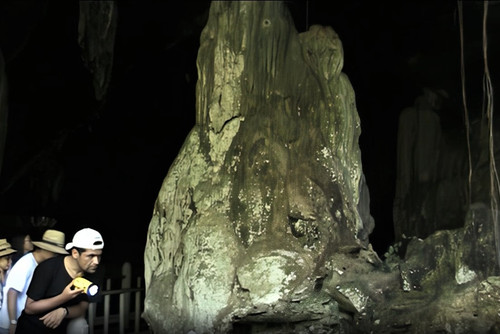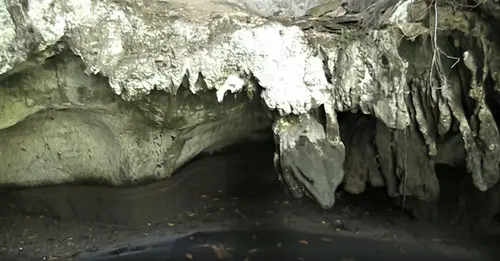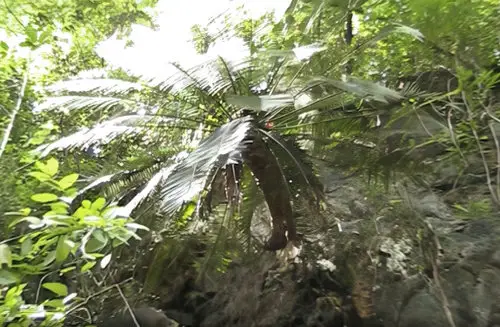Bat Cave Langkawi
Bat Cave (known as Gua Kelawar in Malay) is located on the Kilim river and close to the Kilim Jetty, but on the opposite side of the river. You will need to take a boat to reach the cave. The cave is part of the Kilim Geopark and also shown as part of the
Kilim Geopark Tour.
A footbridge from the boat dock goes through mangrove swamps and right into the Bat Cave. The cave is so named because of the large population of Malaysian Fruit Bats that reside here. The guide or the boatman will give you a flashlight before you enter the cave. It is quite dark and creepy inside.
Footbridge to the Bat Cave Langkawi
As you enter the section of the cave with high ceiling (some 10 meters head clearance), you will get a feel that there are lot many living creatures inside. You won't see them until you point the flashlight towards the ceiling and will be awestruck seeing so many black bats hanging from there and looking at you.
Photo: Khairil Yusof, flickr, cc by 2.0
In fact some will fly right over your head and make screeching sound. Don't worry they are harmless. I am told that there are over 1000 bats that roost at the Bat Cave. They have chosen this dark cave because the temperature and the humidity inside suits them. There are three different species of bats that exist in the cave and feeding mainly on fruits.
Bat Cave Langkawi: Bats hanging from the ceiling
As you walk over the footbridge which goes through the cave with an inside length of about 100 meters, you are asked to keep silence, not smoke and not to flash the light too much into the eyes of the bats as that would be harmful for them. The larger cave with the high ceiling where you find the bats is about 750 sq. meters in area. There is also a smaller cave section with low height (1-3 meters clearance above head) which is about 250 sq. meters in area.
The footbridge goes right through the cave and comes out at the opposite side in the open. As you walk along, look at the dramatic limestone formations in the cave. In one such formation, the stalactite hanging from the ceiling and the stalagmites rising from the floor have joined and formed a massive single column.
Bat Cave Langkawi
Stalactite & Stalagmite forming a column
There are formations that have taken shapes of various creatures. Another such formation looks like a snake, it is also known as the living stalactite. You will see water dripping out of the mouth of the snake.
The snake like formation at Bat Cave
The pontoon footbridge, after coming out in the open from the opposite side, continues through the mangrove swamps. On one side of the bridge is a limestone cliff full of plants and trees. From one section of the bridge as you look up towards the cliff, you will see a strange plant that looks like a fern and hangs off the cliff.
This tree is called Cycad (scientifically known as Cycad Clivicola). It is a primitive plant that existed 200 million years ago even before the days of the dinosaurs. Because it is such an ancient plant, some call it "The Living Fossil".
The Cycads can grow and survive in hard surfaces like limestone rocks and clays. They strangely have features that are similar to that of human beings. For example the female cycads are the most attractive ones, and the plants with big & straight stalks are mails. The females reproduce through seed fertilization that takes place in the female cones.
Cycad at Bat Cave - The Living Fossil
How to reach Bat Cave
You can take a boat from the river jetty of
Tanjung Rhu, or from the
Kilim Jetty located at the north eastern edge of Langkawi. You will need to take taxi to come to the jetty. The Bat Cave is also covered as part of the
Kilim Geopark & Mangrove Tour. The cave is located quite close to the Kilim Jetty. So if you plan to visit only the cave, then take a short boat ride from the Kilim Jetty which will be cheaper and easier.
Map location of Kilim River where the Bat Cave is located
Related Articles
|
Visitors' Reviews/Comments
Share your experience.
|
